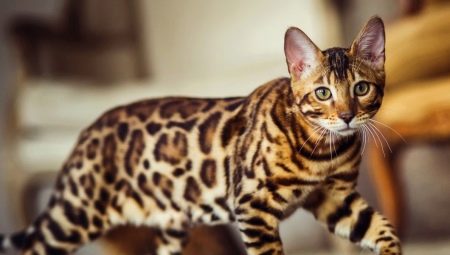Bengals - this is one of those unique cat breeds, which is considered to be very popular due to the distinctive and catchy appearance and unique character traits. The breed first appeared in the United States, where a wild Asian leopard cat was mated with an ordinary short-haired cat. For the first time, Europeans were able to see such a wild cat in the northeast of South Asia - in a historical area called Bengal, from where the name of this magnificent breed came from.
The main difference that the modern breed has is a unique leopard pattern, which helps the color of animals to be considered unique. Bengal cats received this peculiarity from their distant ancestors living in the wild. The wool of the representatives of this breed has a very beautiful and even shine, which becomes especially noticeable in bright sunlight.

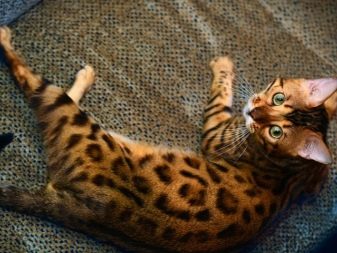
Classification Features
Specialists today distinguish 3 primary colors characteristic of this breed: brown (almost golden), silver and 3 more rich snow colors. In any of these color nuances, there are 2 generally recognized types of patterns: stains and marble. There are special tables by which you can easily determine the color of the Bengal and a description of the features of its color.
Any designation of the color of the cat's hair has a number of groups.
- The name of the breed itself - 3 capital letters in English.
- The name of the base color - 1 or 2 lowercase letters, while the second s means silver, the second y is golden (n is the black color of the breed, ns is black smoky, ny is black and golden).
- Minor part the current index will be indicated, if necessary, and will consist of two numbers.The first is the type of the very sign that is described, for example, the color of the eye or the presence of white spots on the wool, and the second number will characterize the sign itself.
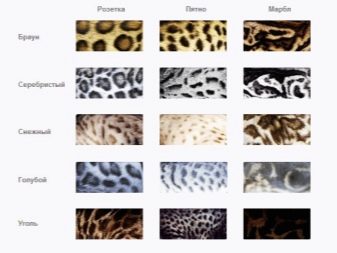

Many reveal the correct color of bengals by number:
- From "0" - the presence of white colors in the coat;
- From "1" - the size of the tipping in the silver group of the breed;
- With "2" - view of the tabby breed;
- With "3" - highlighting the type of color of the point group;
- With "5" - expression of tail length (if tail abnormalities are present);
- With "6" - eye color, it is indicated when colors may vary.
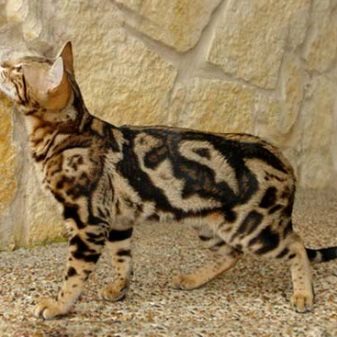
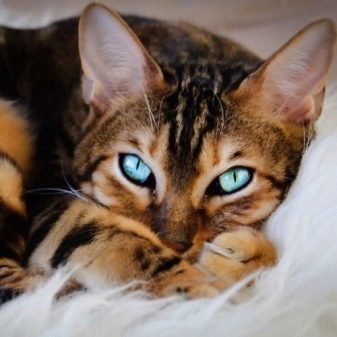
Pattern Types
If, when breeding this breed, breeders strive to maximize bring the appearance of cats to the original (wild), then in colors they have long defeated even nature itself. First of all, you need to mention those pets from whom the bengal got all the best for its breed. Abyssinian cats allowed adding warm tones of apricot to the background of bengal wool. Burmese cats conveyed their unique color called sepia.
Siamese highlighted the case, while leaving dark and much more contrasting bright points. Mau from Egypt presented her silver and bronze color. American cats with short hair laid a marble color in the breed. As a result, a surprisingly bright and beautiful cat came out.
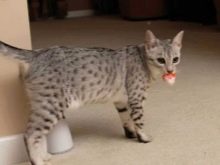
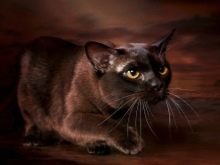
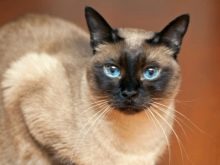
Bengals have more varieties of color than can be expected. Any special color trait in a given breed has its own separate name and a specific characteristic. A Bengal cat is represented by many different colors, they can be divided into 3 types:
- marble;
- rosette;
- spotted.
The distinctive quality of this amazing breed is its special color.
He is marble or catchy spotted - in any case, he will accurately repeat the pattern of the coat of a wild leopard.
Bengal wool has a peculiar and bright pattern - a stain. It is also often called "spotted" - from English spotted or "marble" - from English marble, and it should be as sharp as possible in transitions.
Spots are in the form of a well-known outlet - this is a large spot that has a fringing of dark colors and a much brighter middle. It can take the form of a circle, an oval or even a pointed shape, which is called in unofficial circles “oyster”, “dart”, “tip”, “paws”.
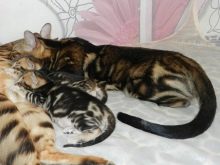
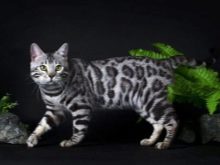

Marble color
Marble colors are estimated to be slightly less than the others, but it’s more difficult to work with. Marble clear stains are located strictly in the horizontal plane. In cats, brown tabby is most often found in all its large selection.
The colors of the background welcome such tones as yellow with brown, bronze with yellow, golden-reddish, reddish-chestnut, dark brown, and even dark chocolate.
The traditional color (brown tabby) is inherent in this breed from the very first days of its existence. It is this color that gives wildlife to Asian leopard cats. Eye color in this case changes from saturated green to bright yellow.
Classic marble is simply unique in appearance, and it is almost impossible to repeat a similar pattern. It represents a large number of different spots, sometimes even the strangest parameters. Such a cat can appear only after the crossing of her parents with similar spots and characteristic patterns on their body. Marble colorings always have a uniform color, they are quite clear and bright. On the body of such a cat there are no stains or half-blurry patches of hair.
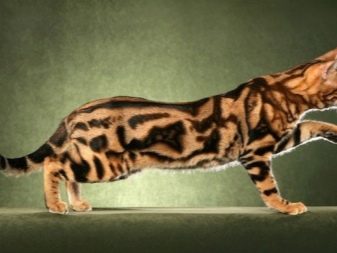
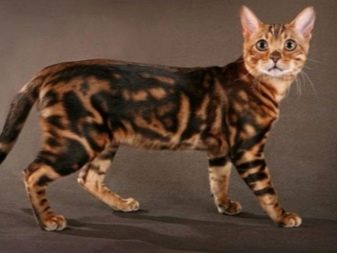
Spotted
Sparks of various sizes, close to a circle, are considered to be the basis of this kind of coat color for Bengal cats. These spots most closely resemble the drawing on the body of a wild leopard - an ancient cat, from which bengals came from. Horizontal stripes in color are also common, but only on the shoulders of the cat.
The color scheme can vary from very light to catchy brown, and even to jet black.This kind of coloring today can be considered one of the most popular.
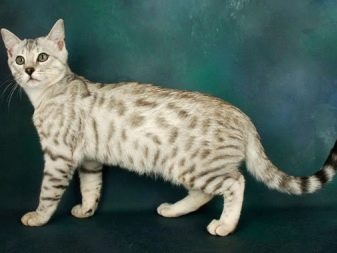

Rosette
Rosettes (rosette) look like stretched rings and half rings, can be remotely similar to a small footprint, dart or even a bunch of grapes. Large rounded spots with a full color are also called rosettes.
Here, preference will be given to those patterns that are obtained from the same spots, located as evenly as possible, and separately from each other.
It is imperative that they do not merge into tiger stripes, as this is considered a minus of the breed. Large types of outlets should also not pass one into another.
The standard for today's breed of bengals is the following original pattern on the face:
- side view - very dark, but bright stripes;
- on the forehead - an image similar to "M";
- on the neck - stylish “necklace”.
Small spots, stripes or a pattern similar to butterfly wings are visible on the shoulders. The pattern on the legs can be speckled or even striped.
The tip of the tail will be only black, along its entire length there may be rosettes on gold or bright rings. On the stomach, chest, chin, as well as on the pads and the inner side of the legs of the ring the ring is always lighter than the main background, spots can be located on the stomach.
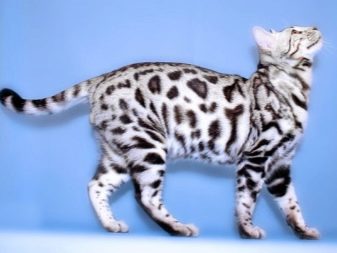
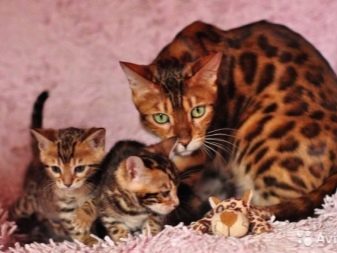
Common colors
Out of a huge number of color types, nature gave these little wild predators only one - “black spotted tabby”, and it is ideal for high-quality camouflage in the wild. In this case, the coat can have colors ranging from delicate sand and gray to the darkest chestnut, depending on the environment of the cats. At the same time, the hybridization process made its own changes in the breed of bengals, and very interesting varieties appeared in the standards.
The TICA standard distinguishes 5 different colors. All of them, according to genetics, are black, but due to the increased degree of rufism, the color of cats often looks like tan, leopard. Therefore, these colors are called:
- brown spotted marble tabby;
- silver spotted marble tabby;
- seal sepia spotted marble tabby;
- seal mink spotted marble tabby;
- seal spotted marble lynx-point.

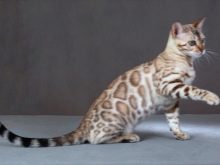
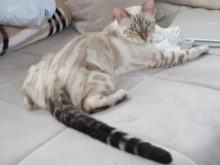
In all of the above colors, specialists allow 2 types of patterns described above. In addition, a number of standards take into account blue colors. In this case, there may be combinations of all 4 of the listed colors and 2 patterns with silver wool.
Sometimes breeders get completely black cats (melanistic), chocolate-colored kittens, and even purple cats with tortoiseshell colors.
But these colors are not yet considered correct, because such seals are not used for breeding.
It is brown tabby that is considered the initial variety of the modern breed of bengal. The wild cat Malaysia, which was crossed with the Abyssinian black cat, had a similar color in its time. Spots and stains (and monochromatic as well) in their descendants are both completely black, with a transition to the shade of black chocolate, and brick-brown, and even with a tan subtle.
In this noble breed, sockets are very highly rated. They are either two-tone or consist of 3 colors, with 3 shades still preferable. This is a breed with a tiger color of the legs, which is very popular among potential owners.
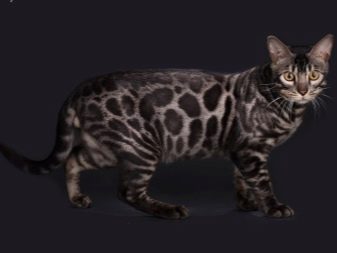

Snow color
This is the most original color in the breed. The clarified color of the coat can be considered characteristic here, and sometimes the capital color can be basically whitish or light gray. Snow color is rich in a range of colors.
On top of the pale pale background of the picture, you can see different tones: from darkened brown to catchy orange, and different shapes of the picture itself are allowed. Marked stripes or even spots may also be present. The color of the eyes of such a cat is bright blue, but the tip of the tail will be brown, but sometimes other options can be found.
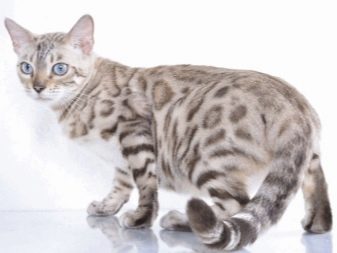
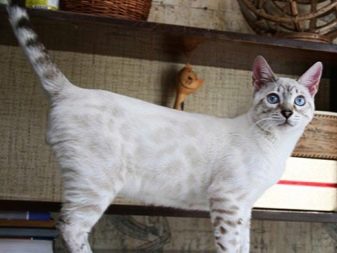
Gold
It usually has shades ranging from pale yellow to rich golden, while the pattern itself may be black or chocolate. The standard of such an unusual color is a catchy black stroke, which emphasizes the cat's eyes, outlines its nose and mouth.
The cat will have paws and the tip of a tail of black coloring, but spots in other places of the body can be approximated to a chocolate tone. The eyes will be green or even bright yellow, but with different shades.
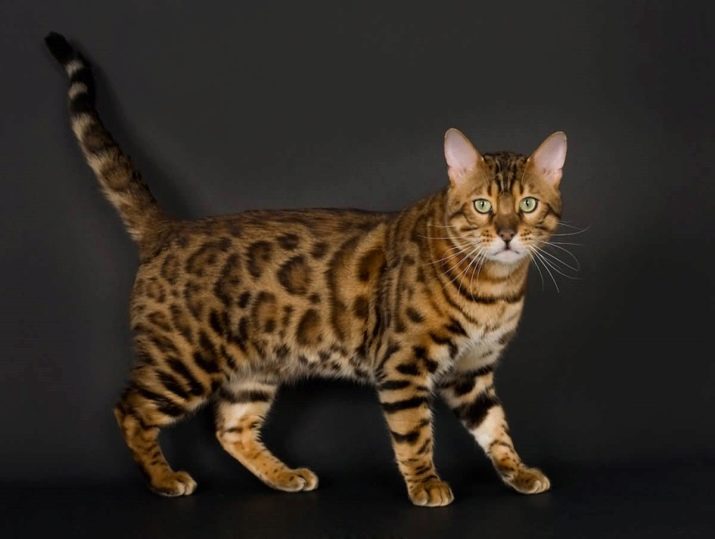
Silver tabby
The cat of this color has the main white-silver shade of the background, with a discreet grayish tint. Drawing on such a silver background is strikingly highlighted in bright black with contrast, most often it is very clearly defined. The shapes of the spots vary, long stripes or small spots are acceptable.
In the area of the back, the cat may have a slight dimming of the coat, but it may not be. In the wild, there is a snow leopard having a similar color.
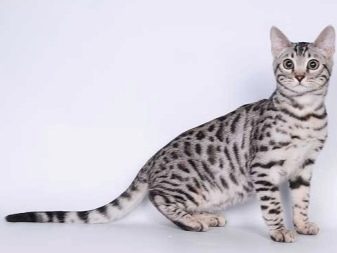
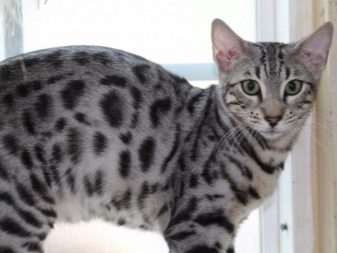
Redhead
The basic background of the red color will be warm - from bright yellow to rich golden tones. The drawings on the torso of the cat will differ in the black or darkest color of the chocolate. The color of the animal’s eyes is noble shades of bright yellow or green, almost emerald. The cat's paws and the tip of its tail will be the usual black color. The main feature is a black shell around the eyes, nose and mouth.
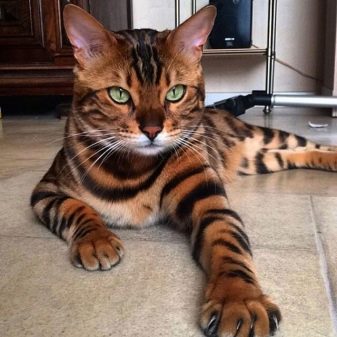
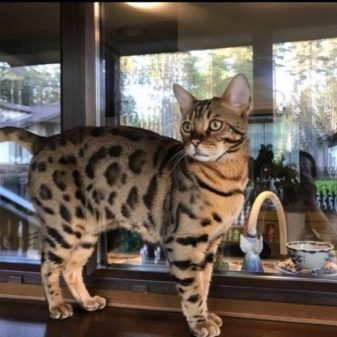
The rarest colors
Sometimes, but there are Bengal cats that have a completely unusual color.
Melanist
This is usually called a black Bengal cat, because it is considered the owner of black patterns placed on the same black background. This pattern resembles the color of a black panther (a special color variant of the wild leopard).
The pattern and title background of such bengals has a black color. In sunlight, the pattern is clearly visible, and therefore it can be understood that this is a Bengal breed, and not some other.
Black Bengal cat is an extremely rare species of this breed. Associations of breeders most often do not approve of this kind of color, so it is not considered popular.


Coal color
The basis of the color of Bengal wool in this case are cool and light tones of gray colors. They will most clearly and clearly outline the main drawing. There are almost no blurry spots or stripes, the pattern is bright and clearly visible on the faded background of the main color. Around the eye of this cat there is a light rim. The spots are scattered on the torso of the cats quite evenly, the color is similar to the traditional spotted color, but stands out with a brighter and darker color of the pattern.
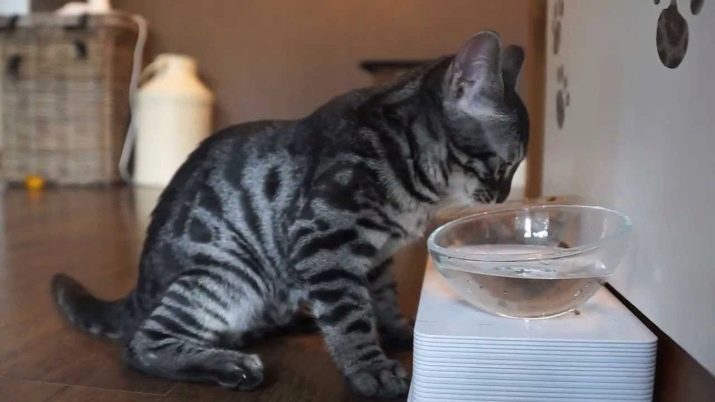
Blue
This is a very rare coloring of bengals. The coat of babies with a similar color is like silver, but has a pleasant shimmer in blue.
This is a smoky-colored kitten with a visible blue coat color; almost imperceptible gray spots can sometimes appear on it.
Most often they are in the form of a circle, there may be stripes in certain sections of the body.
On the belly and in the chest area of the kitten you can often see a peach tide. Blue color is considered today the last Bengal color of those that appeared officially, which can be in a cat.
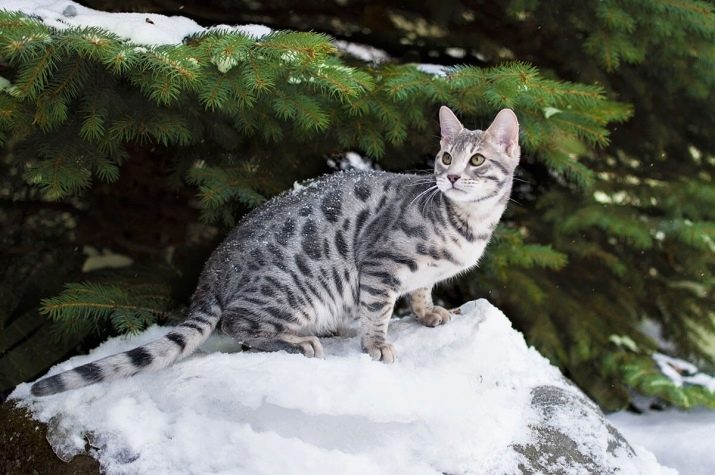
Snow
Snow coloring, which is recognized as the lightest, and at the same time is also very spectacular and original, is divided into the following types.
- Sepia. It is considered the darkest of all types of snow colors of bengals. The background is catchy gold, very close to the highlighted orange. The colors of the hull and spots are not very distinguishable. The paw pads and the tip of the ponytail will have a catchy brown tint. Eyes play with a golden or bright yellow undertone.
- Minks. The main background has a cream or golden hue. The patterns on the cat's body are both dark orange and light brown, quite contrasting with the main color. The tip of the tail is brown. Eye color - bright blue, piercing.
- Lynx. The main color has amazing shades of ivory, and sometimes it is cream. The patterns on the body are most often marble, but rosettes, and even spots, can be found. Paws, muzzle, tail and ears will be significantly darker than the main background. The eyes are blue.
Kittens of all the listed colors at birth have a white or light color, as they grow (not earlier than the animal turns one year old), the pattern begins to change - it becomes clearer. The full color "matures" by about 1.5 years, when the cat becomes an adult.
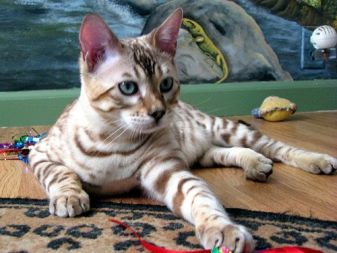
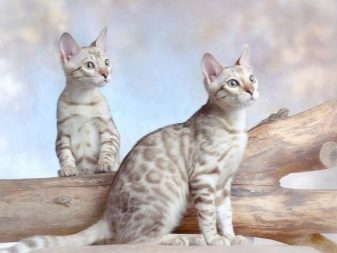
Read more about the Bengal cat in the video below.
